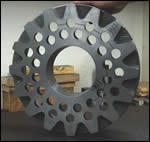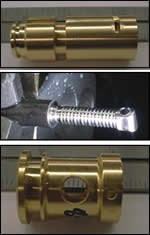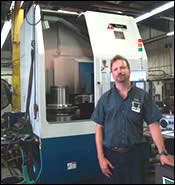Vertical Turning Proves Profitable
A precision machined parts manufacturer augments its production turning operations by expanding its CNC equipment and infrastructure to include vertical turning of large parts. The result has been a lucrative—and growing—additional revenue stream.
Mark Vanistendael, president of Davan Manufacturing Inc., is always on the lookout for a new piece of technology to bolster his machining arsenal. “The way I look at it, we should always buy the most advanced machine we can afford, because it isn’t long before the competition catches up.” Expanding Davan’s machining capabilities gives the Washington, Pennsylvania, company the flexibility to pick up market share in an area that has been hard-hit by economic fallouts, off shoring and skilled labor shortages.
Staying on the cutting edge of new technology has kept the company successful for almost 40 years, through some tough economic times. “My father started this business in 1968 making screw machine-type hardware for the electronics industry,” Mr. Vanistendael says. “When that industry left the Pittsburgh area, he diversified into the glass, steel and mining industries. In the late 1970s, we were one of the first companies in Southwest Pennsylvania to add CNC machining capabilities to make parts that were being made on conventional machinery.”
Throughout the years, the company has continued to adapt to an ever-changing economic climate. For example, in the early 1980s, the company added a CNC machining center to accommodate larger valve work. It then pursued smaller valve parts and other bar work by investing in automatic lathes with driven tooling and fully programmable C axes.
“We tackled small, intricate C-axis work requiring lots of milling and drilling,” Mr. Vanistendael says. “We were competitive because our parts were coming out of the machine complete.”
Changing Times
Although Davan stayed on the forefront of CNC machining technology in its early days, tough competition and eroding profit margins put the brakes on new equipment acquisitions. When Mr. Vanistendael bought the company from his father in 1996, he found himself saddled with a great deal of mid-1980s equipment.
He knew he had to upgrade his shop, so he began working with distributor Allegheny Machine Tool Systems Inc. (Canonsburg, Pennsylvania). His first acquisition was a 10,000-rpm CAT 50 machining center with through-spindle coolant. The small VMC let Davan tackle small parts such as aluminum billet-type gear housing boxes and valve parts.
As business picked up, Mr. Vanistendael invested in other equipment with proven production advantages. “I don’t want plain lathes or machining centers. I seek out advanced machines with live tools, shuttle pallets and high-pressure coolant,” he explains.
Through the years, the company has expanded its capabilities to handle everything from ½-inch bar to 3-inch bar. It also added turning centers with subspindles for tackling workpieces in one setup.
Although the company has successfully carved a niche in the medium- to high-production area, it’s always looking to incorporate more capabilities. In the past couple of years, Davan has moved to yet another level—making larger parts for a booming oil field industry using vertical turning technology.
Vertical Versatility
Vertical turning centers (VTCs), as their name implies, orient the axis of the spindle vertically rather than horizontally. This arrangement allows operators to load big, heavy parts easily. They don’t have to fight gravity the way they would with a conventional horizontal turning center. These machines also provide advantages in terms of chip removal. In addition, VTCs provide greater production flexibility and the capability to tackle larger parts in a smaller machine footprint.
The downside to VTCs—until recently—was their cost compared to their horizontal counterparts. Fortunately, their price has come down, making them an attractive and affordable option for many smaller shops.
Davan has been one such shop. Adding a VTC to its mix of conventional production equipment has opened the doors to new work and provided quick ROI. “For example, we’re running down-hole drill equipment on our vertical turning center,” Mr. Vanistendael explains. “Previously, our customer did these parts in-house on manual Bullards, maybe 12 or 13 pieces a year. Cycle times were typically 10 hours. Now, they’re looking at 30-, 40-, even 50-piece orders. We can do the part in half the time, and the quality is better.”
Davan originally bought the VTC to do secondary-operation work on parts coming off a horizontal turning center. However, it quickly scrapped those plans when it ended up running completely different work on the VTC. “The machine puts us in a new size class,” Mr. Vanistendael says. “We’re now quoting on bigger pieces. There’s a demand for parts we hadn’t run prior to the acquisition of the VTC. We’ve found that machining these larger parts has been a great revenue stream for us.”
Finding The Right VTC
When Mr. Vanistendael made the decision to invest in a VTC, his major concern was finding a big, strong machine that could tackle the work he wanted to pursue. “I specifically wanted a geared head machine that had the low torque necessary for those big workpieces. I wanted a machine with a strong casting, and I wanted a machine with a competitive price.”
Allegheny took Mr. Vanistendael to Absolute Machine Tools Inc. where he saw a You Ji YV-500E VTC up close—very close. “We climbed around inside that machine and saw the strength of the casting for ourselves,” recalls Mr. Vanistendael. “The You Ji also had a ZF gearbox. In addition, we did our homework and got recommendations from other You Ji users doing flange-type work for pump bodies and automotive work.”
The VTC is designed for stand-alone applications or easy integration into production lines. It comes in mirror-image right- and left-hand versions, allowing shops to place machines side by side. Such an arrangement boosts productivity by giving shops two spindles in essentially the same space as one horizontal turning center. This also allows one operator to run two machines.
Solid machine construction is key to the VTC’s performance. The 22,000-lb machine boasts Meehanite castings, heavily ribbed to reduce thermal distortion and damp vibration. Completely enclosed X- and Z-axis linear guideways ensure high precision. Boxways are also available.
The spindle construction is a heavy-duty design incorporating high-precision, double-roller bearings and 45-degree angular contact thrust bearings. A 30-hp high torque Fanuc spindle motor provides more torque at lower rpm than a Fanuc 50-hp single- wound motor and delivers power for heavy-duty machining and high speed for fine finishing.
For greater flexibility, shops can add an optional positioning-only C axis with ten live tool turret stations. The C axis can be positioned to 0.001 degree for drilling and tapping. The live tooling used for the C axis is backed by a 5-hp spindle motor that delivers as much as 1,600 rpm.
Cutting On The VTC
A typical part showcasing Davan’s capabilities is a 15-inch-diameter bearing sleeve for an oil well. The precision part weighs approximately 580 lbs and is made from 4140 steel castings. It also includes a heat-treated zone where the seal rides.
Davan rough cuts its first and second operation on the You Ji (about 0.0150-inch depth of cut), sends the part out for heat treatment, and then finish cuts all the bearing surfaces, cutting through the heat-treated material, taking it to size and finishing a groove. “We flip the part over and finish the counterbore and the bore on the other side,” Mr. Vanistendael explains. “The part has a rather large groove in it that’s about 1 ½-inch deep. It also has a six-pitch thread. The You Ji handles the heat-treated part without a problem. It’s about 50 Rc, and we’re running about 600 fpm. On the roughing cuts, we run light, probably 0.020 ipr. When we hit the finish cut, it’s probably about 0.005 ipr.”
The main concern on the part is a quality issue. The part goes straight to assembly, so it has to fit right the first time. Cycle time is another consideration because Davan wants to take big cuts to get the parts out the door as quickly as possible.
Planning For The Future
Currently, Davan machines prismatic parts up to a 31-inch cube and turns parts from a 1/2-inch to 31-inch diameter. While the company specializes in mill/turn center work offering the economies of “done in one” setups, it is well positioned to take advantage of a number of machining resources, including vertical turning. Supporting Davan’s CNC production capacity is the latest CIM technology, including shopfloor control software, estimating and routing software, Gibbs CAD/CAM software and a DNC network to the CNC machines.
Davan’s mission states, “To offer our customers cost-effective production machining services, big company resources, small company responsiveness and quality workmanship.” To meet these goals, the company continues a well planned and researched capital equipment expansion. For example, the company recently sold its 1980-vintage bar machines and replaced them with a new turning center with a dead length collet and bar feeder. It is also going to a larger and more robust lathe that will provide increased efficiencies by completing larger C-axis and Y-axis parts in one setup.
Such additions, along with the capabilities of the VTC, let the company compete in a variety of industries and quote on a variety of part sizes. This flexibility ensures the company’s continued growth and allows it to pick up market share as the economy changes and new business opportunities arise.
“Shops can’t afford to only do one thing anymore,” Mr. Vanistendael says. “You have to be a mix of things. Shops have to be ready to do just-in-time for customers, stock parts for them and even do some assembly. We separate ourselves from the competition by offering a mix of machining technologies along with value-added engineering and design services. We can take complete responsibility for processing customer jobs, including outside services, to ensure they can purchase a complete assembly.”
Related Content
Does a Scanning Probe Make Sense on a Swiss-Type?
Swiss-types have limited tooling capacity, but there can be advantages to giving up some of that capacity to take advantage of a touch probe — in fact, a scanning probe — to enable in-process part measurements.
Read MoreWhen a CNC Turn-Mill Doesn’t Turn
A shop in Big Sky Country uses a B-axis multitasking machine to produce complex, prismatic medical parts that require no turning complete from barstock.
Read MoreSoftware Controls Chip Breaking in Thread Turning Operations
This cutting tool manufacturer has developed a software module for chip control of thread turning operations in virtually any CNC lathe, even for older machines, using specific tooling and software.
Read MorePursuit of Parts Collector Spearheads New Enterprise
While searching for a small parts accumulator for Swiss-type lathes, this machine shop CEO not only found what he was looking for but also discovered how to become a distributor for the unique product.
Read MoreRead Next
Emerging Leaders Nominations Now Open
Here’s your chance to highlight a young person in your manufacturing business who is on the path to be a future leader moving your company forward.
Read MoreA Tooling Workshop Worth a Visit
Marubeni Citizen-Cincom’s tooling and accessory workshop offers a chance to learn more about ancillary devices that can boost machining efficiency and capability.
Read MoreDo You Have Single Points of Failure?
Plans need to be in place before a catastrophic event occurs.
Read More











.jpg;maxWidth=300;quality=90)


.jpg;maxWidth=300;quality=90)










